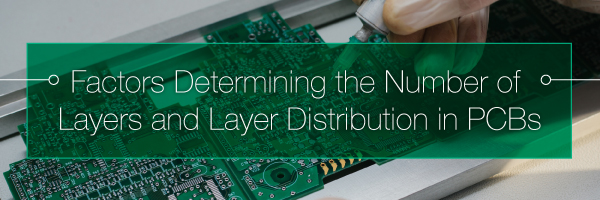
PCB successfully added to your shopping cart


Printed circuit boards (PCBs) consist of anything from one layer to multiple layers of dielectric and conductive materials. When bonded into boards, these layers carry circuits that power a vast range of home electronics, such as alarm clocks, kitchen appliances, desk supplies, computers and mobile devices.
PCBs are also used in a vast array of industrial tools and machinery, as well as medical devices, government computers and storage systems, and aerospace equipment. The number of layers and dimensions of a particular board determine a PCB's distribution of power.
PCB layers are the determining factor in the power and capacity of a printed circuit board. People often wonder whether a one-layer PCB will suffice, or if it is better to go with a two- or four-layer PCB - hint: there is no such thing as a three-layer PCB - or something in the multilayer range.
While the number of layers largely depend on your budget and functional needs in a PCB board, this does lead to question - what exactly are multilayer PCBs? Basically, "multilayer" refers to anything with more than two layers, such as a 4-layer PCB or something in the 6-layer to 12-and-up range.
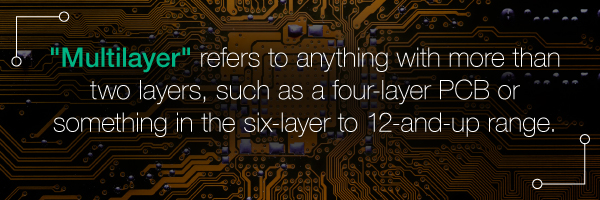
As you consider how many layers would be ideal in an order of PCBs, you need to consider the factors that make a multilayer favorable to a single- or double-layer, and vice versa.
1. How will my printed circuit board be used?
When calculating the needs of a printed circuit board, consider the types of machines and devices your PCBs will be used in and the demands these machines/devices will place on the board circuitry. Will these PCBs be used in high-tech, complex electronics or in simpler items with minimal functions?
2. What operation frequency is needed?
As you take these questions into account, consider what you will need in terms of operation frequency. Its parameters determine the functions and capacity of a PCB. For higher speed and operating capacity, multilayer PCBs are essential.
3. What is my budget for the project?
Other things to consider are the manufacturing costs of single- and double-layer PCBs versus multilayers. If you want to have the highest capacity possible in today's circuit board technology, you will need to pay for the high manufacturing costs involved.
4. How quickly do I need the PCBs?
Lead time - the time it takes to manufacture a set of PCBs of single vs. multiple layers - is also something to consider when you order a large shipment of printed circuit boards. The lead time for one- and two-layer boards could be anywhere from 8 to 14 days, depending on the size of the board area. Then again, if you are willing to pay more or less, the lead time could be as short as five days or as long as a month.
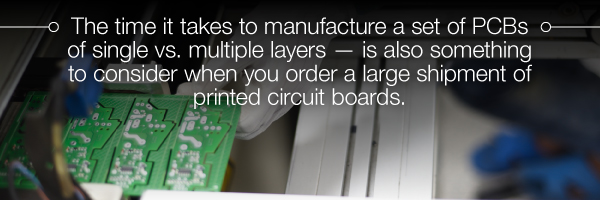
The lead time will increase, per board size, with every layer you add to the order. PCBs in the four- to 20-layer range could have a lead time of anywhere from 12 to 32 days, depending on whether you want the boards to have small or large dimensions.
5. What density and signal layers are needed?
The number of PCB layers also depends on pin density and signal layers. As indicated by below chart, a pin density of 1.0 will necessitate 2 signal layers, and the number of necessary layers goes up as the pin density drops. With a pin density of 0.2 or less, you will need PCBs with at least 10 layers.
| Pin Density | Signal Layers Number | Multilayer PCBs Layer Number |
| >1.0 | 2 | 2 |
| 0.6-1.0 | 2 | 4 |
| 0.4-0.6 | 4 | 6 |
| 0.3-0.4 | 6 | 8 |
| 0.2-0.3 | 8 | 12 |
| <0.2 | 10 | >14 |
A single-layer PCB consists of one laminated and soldered layer of dielectric, conductive material. As an early component of electronic equipment, the single-layer PCB has been in use since the late 1950s. Even today, despite its relative primitivism by modern standards in home electronics, the single-layer PCB remains common throughout the world.
The construction of a single-layer PCB is simple, as it consists of one thermally conductive dialectic that is covered first with a copper laminate and topped off with a soldermask. Illustrations of the single-layer PCB will generally show three strips of color to represent the layer and its two covers - gray for the dielectric layer itself, brown for the copper laminate and green for the soldermask.
Due to their simple design, single-layer PCBs are easy to manufacture in vast quantities and are therefore the most cost-effective of all printed circuit boards. Though the single layer is a limited technological component by contemporary standards, it still provides manufacturers with the following benefits:
• A simple design most manufacturers can easily understand
• Uncomplicated, and therefore unlikely to pose any production issues
• Affordable and convenient for production in vast quantities
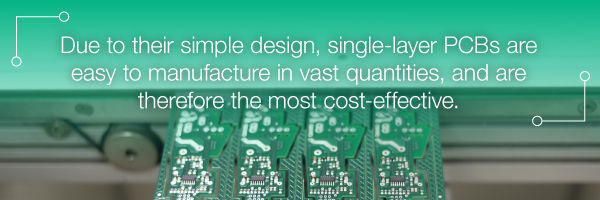
Today, single-layer PCBs are manufactured with a copper-laminate thickness of anywhere from one to 20 ounces. Single-layer PCBs are designed to operate in a temperature range of between 130 and 230 degrees Celsius.
In earlier decades, single-layer PCBs were used in most electrical devices. Today, most high-tech home electronics have moved on to multilayer PCBs, which are optimized for a more complex range of demands. Nonetheless, the single-layer PCB is still common in some of the simpler devices in living rooms, kitchens and offices, including:
• Calculators - Some of the most basic calculators work with single-layer PCBs.
• Radios - Some radios, such as the low-priced radio alarm clocks from general supply stores, often use single-layer PCBs.
• Coffeemakers - Coffee-making appliances often use single-layer PCBs.

The single-layer PCB is also common in sensors, LED lights, printers, surveillance cameras and timing circuits.
The two-layer PCB is the next step up in printed circuit board technology. With its higher capacity, the two-layer PCB - alternately called a double-layer PCB - can support a wider range of contemporary electronics devices than the one-layer PCB. At the same time, two-layer PCBs are much less complicated from a manufacturing standpoint than the various multilevel printed circuit boards on today's market. As such, the two-layer is the most widely used PCB option.
A two-layer PCB is much like a one-layer PCB, but with an inverted, mirror-image bottom half. With the two-layer PCB, the dielectric layer is thicker than in the single-layer. Furthermore, the dielectric is laminated with copper on both the top and bottom sides. Moreover, the lamination is covered with soldermask on both the top and bottom.
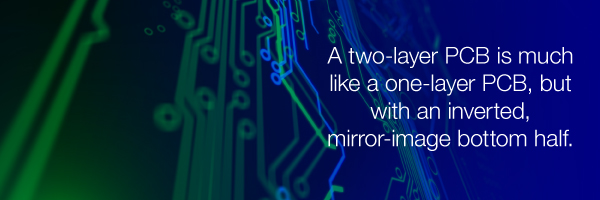
Illustrations of the two-layer PCB generally look like a three-layer sandwich, with a thick grey layer in the middle that represents the dielectric, twin brown strips above and below that represent the copper and thin green strips along the top and bottom that represent the soldermask.
Thanks to its equal top and bottom sides, the two-layer PCB allows for more routing traces. The benefits of the two-layer PCB include the following:
• A flexibility of design that makes it suitable for a broad range of devices
• Dense circuitry that makes it suitable for a range of modern-day applications
• Low-cost construction, which makes it convenient for mass production
• Simple design, which makes it easier for manufactures around the world to understand
• Small size, which allows it to fit in a variety of devices
Two-layer PCBs are applicable to a vast range of simple and more complex electronics devices. Examples of mass-manufactured devices that have contained two-layer PCBs include the following:
• HVAC units - Residential heating and cooling systems from various brands have contained double-layer printed circuit boards.
• Amplifiers - The two-layer PCB has equipped the amplifying units used by numerous musicians.
• Printers - A variety of computer peripherals rely on two-layer PCBs.
The two-layer PCB has also been used in control relays, power supplies, LED lighting, line reactors, testing equipment and vending machines.
A four-layer board consists of a more complex set of layers than the one- or two-layer PCB. Whereas both the single- and double-layer PCB contain a single row of dielectric material, the four-layer PCB contains several. As with all multilevel printed circuit boards, the four-layer PCB includes several layers of conductive material and copper between the top and bottom soldermasks.

The four-layer PCB stackup consists of the following layers:
• Four strips of conductive copper
• Three inner-dielectric layers - two prepreg and one core
• Twin dielectric soldermask layers at the top and bottom
In 4-layer PCB design, the 4 copper strips are divided internally by 3 inner dielectrics and sealed at the top and bottom by soldermask. Generally, 4-layer PCB design rules are illustrated with 9 strips and 3 colors - brown for copper, gray for core and prepregs and green for soldermask.
Even though the common illustrations of four-layer PCB design would seem to indicate the prepreg and core layers consist of the same material, the former is not totally cured, and is therefore softer than the core. During the manufacturing process, heat and pressure are applied to the four-layer stackup that causes the prepreg and core to melt and bond the layers together.
Four-layer PCBs are advantageous to manufacturers on numerous fronts, as these and other multilayer printed circuit boards provide the following benefits:
• Durability - The four-layer PCB is stronger than one- and two-layer boards.
• Compact size - The small design of the four-layer PCB can fit into a vast range of devices.
• Flexibility - The four-layer PCB can work in numerous types of electronics, both simple and complex.
• Safe - With proper alignment of power and ground layers, the four-layer PCB shields against electromagnetic interference.
• Lightweight - Devices equipped with four-layer PCBs have less need for internal wiring, and therefore often weigh less.
Though production of multilevel boards requires greater expertise, any additional four-layer PCB cost is earned back tenfold by the higher valued products the four-layer can mechanically support. Some of the most essential modern-day devices to feature four-layer PCBs include the following:
• Satellite systems - Multilevel PCBs have equipped the orbiting satellites that have enabled communication on a global scale.
• Handheld devices - Phones and tablets are often equipped with four-layer PCBs.
• Space probe equipment - Multilayer printed circuit boards have powered space exploration devices that have allowed us to see far into the galaxy.

Four-layer PCBs are also common in X-ray equipment, file servers, atomic accelerators, CAT scan technology and nuclear detection systems. More so than one- and two-layer PCBs, four-layer circuit boards can also be of benefit to processes where crosstalk is an issue.
The six-layer PCB is where circuit board technology really starts to get into the more advanced aspects of today's electronics. With the six-layer PCB, manufacturers can power a range of commercial tech products, health care devices and industrial machinery.
The six-layer PCB stackup is similar to the four-layer, but with two extra copper layers and two additional rows of dielectric material. In the six-layer stackup, the second and fourth dielectric rows are labeled as "core", and the first, third and fifth are prepreg. Of the six conductive copper rows, the second and fifth are plane and the rest are signal.
Since their development, 6-layer PCBs have been a boon to the electronics industry. With their vast technological superiority to single- and dual-layer boards, they have allowed manufacturers to bring a whole host of innovative devices before the public. Some of main advantages of six-layer PCBs include:
• Strength - The six-layer PCB is thicker and therefore stronger than its more thinly layered predecessors.
• Compactness - With six layers, boards of this thickness have greater technological capacity, and can therefore consume less width.
• High capacity - PCBs with six or more layers provide electronics devices with optimal power and greatly reduce the possibility of cross-talk and electromagnetic interference.

Multilevel printed circuit boards of six layers or more have allowed computer technology to grow in leaps and bounds over the past two decades. PCBs of this level have advanced the following electronics:
• Computers - 6-layer PCBs have helped fuel the rapid evolution of personal computers, which have become more compact, lightweight and faster.
• Data storage - The high capacity of six-layer PCBs have made data storage devices increasingly resourceful over the past decade.
• Fire alarm systems - With circuit boards of 6 layers or more, alarm systems've become ever more precise at detecting real danger the moment it arises.
Six-layer PCBs have also been used in cell phone transmission, fiber-optics receptors, heart monitors, industrial controls and GPS technology.
As the multilayer printed circuit boards increase in layer count beyond the numbers four and six, further layers of conductive copper and dielectric material get added to the stackup.
For example, an eight-layer PCB contains four plane and four signal copper layers - eight in all - bonded by seven inner rows of dielectric material. The eight-layer stackup is sealed at the top and bottom with a dielectric soldermask. Basically, the eight-layer PCB stackup is much like the six-layer, but with additional pairs of copper and prepreg columns.
The trend continues with the 10-layer PCB, which adds two more layers of copper for a total of six signal and four plane copper layers - 10 in all. Bonding the copper in the 10-layer PCB stackup are nine columns of dielectric material - five prepreg and four core. Ten-layer PCB stacks are sealed, like all others, with dielectric soldermask at the top and bottom.
By the time you get to the 12-layer PCB stackup, you have a board with 4 plane and 8 signal conductive layers, bonded by 6 signal and 5 core columns of dielectric material. 12-layer PCB stacks are sealed with dielectric soldermask. In general, multilayer PCB illustrations depict the layers and bonding materials with the following colors - brown for signal/plane copper, gray for prepreg/core dielectric material, and green for top/bottom soldermask.

Multilayer PCBs of the eight-, 10- and 12-layer varieties are beneficial in numerous high-tech devices and computer systems. In recent decades, the development of multilayer printed circuit boards has led to the rapid advancement of computer technology - from the kHz systems of yore to the GHz machines of today.
Machines and devices in a range of sectors - commercial, industrial, medical, government, aerospace - continue to grow in speed, capacity, compactness and ease of use, thanks to the rapid developments afforded by today's increasingly complex multilayer PCBs.
The easiest way to think of a printed circuit board is to imagine the layers like a lasagna where conductive and dielectric materials bond together within a soldermask. Four-layer boards, for example, usually consist of evenly spaced layers with planes in the center. While this can make the board appear symmetrical, it doesn't necessarily have the most desirable effects when it comes to electromagnetic compatibility.
Another arrangement that can yield undesirable effects is to closely pair the two planes in the middle, while the signal layer and planes sandwich large dielectrics. Even though this arrangement does allow for the storage of electric charge at the inter-plane, it can cause undesired signal transmission and electromagnetic effects. For these reasons, today's experts in the PCB field generally opt for boards of at least four layers, as opposed to two.
To boost the electromagnetic compatibility of a four-layer board, the planes and signal layers should be spaced together as closely as possible. Also, the core between the ground plane and power should be large. This arrangement will reduce the possibility of undesirable signal transmissions between the traces and keep the opposition between circuits and currents at acceptable levels.
An ideal range of opposition between circuit and current would be in the ballpark of 50 to 60 ohms. Remember, when the impedance is low, the drawn current spikes, which is an undesirable effect. High impedance will generate greater amounts of electromagnetic interference and render the board more vulnerable to foreign interference.
Today's world is equipped with electronics devices of all sorts that offer numerous features that would have not been technologically imaginable even 50 years ago. Many of these developments are due to the capabilities afforded by PCBs. PCBs make it possible for conveniently compact devices to perform a range of complex tasks, many of which can be prompted remotely.
Since 2005, PCBCart has been manufacturing printed circuit boards to more than 10,000 companies worldwide. With more than 99% customer satisfaction, our boards have been widely used to support a vast range of products. To learn more about our PCB options, please check following pages:
• Multilayer PCB Benefits and Applications
• Full Service PCB Fabrication Services up to 32 Layers
• Advanced Turnkey PCB Assembly Service – Lots of Value-added Options
• Benefits of Choosing PCBCart as Your PCB Partner
Interested in ordering a single layer or multilayer PCB? Get a free, no obligation quote today!
Get FR4 PCB Fabrication Price within Seconds
Request Quote for Advanced PCBs (Flex PCBs, etc.)
Helpful Resources
• Printed Circuit Boards Introduction
• Single-Layer vs. Multi-layer PCBs
• Necessity&Advantages of Multilayer PCB
• PCB Layer Stackup, PCB Stackup Design | PCBCart
• PCB Manufacturing Process — A Step-by-Step Guide
• PCB Board Material, PCB Material Type